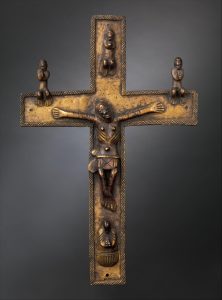8 Chapter 8: Art of medieval Africa
Maria Americo
Chapter 8: Art of medieval Africa
Welcome to chapter 8, where we’ll explore some of the rich artistic traditions of the regions of medieval Africa. Let’s get to it.
Crucifix
Republic of the Congo
16th-17th century CE
-Image by the Metropolitan Museum of Art, used under a Creative Commons Zero (CC0) license, Public Domain
-Learn more about this art and find the image source here.
This brass crucifix was made by an artist of the Kongo people, in what is today the Republic of the Congo. When Portuguese explorers, traders, and missionaries reached the area in the late 1400s, sub-Saharan Africa was a thriving region, with many languages, religious practices, tribal groups, settlements, and trading networks. Local people began to trade goods with the Europeans, of course. But as always happens when different peoples meet, intangible things like religion and art were exchanged too.
The Portuguese and other Europeans brought Christianity, and Christian art and iconography, with them to Africa. In what is now the Republic of the Congo, a local Kongo king in the sixteenth century established Christianity as the state religion for his people. This change opened up a new network for the transfer of both goods and ideas between Europe and Africa. It also led to the creation of religious art pieces such as this one, where European iconography was adapted to African styles by a local artist.
Questions for reflection
- Based on the art we have explored so far in this book, can you make any determinations about which aspects of this art are more “European,” and which are more “African”?
- Describe the condition of this piece of artwork. Does it show signs of wear?
- What other examples have we encountered so far of intangible ideas, like religion, philosophy, or art styles, moving across borders in the premodern world?
Source and further reading for this art
Credo Reference – African Christianity
2. 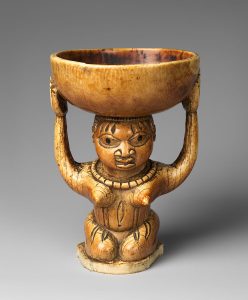
Divination vessel
Nigeria
17th-19th century CE
-Image by the Metropolitan Museum of Art, used under a Creative Commons Zero (CC0) license, Public Domain
-Learn more about this art and find the image source here.
The practice of divination is one of humanity’s most ancient ways of using ritual in order to learn more about our place in the universe. Every ancient culture on earth had some tradition of divination rituals. Divination is asking a question about our fate, destiny, decisions, relationships, or other aspects of human life of some external tool (such as cards, tea leaves, the flight of birds, the weather, the stars, or even, as in modern pop culture, a crystal ball), with the belief that the universe speaks to humans through the medium of these external tools.
With this artwork from what is today Nigeria, we see evidence for premodern African use of divinatory ritual, from the Yoruba tradition. The woman depicted at the base of this artwork represents the seeker asking her question—in divination, this person is called a querent. The priest, the user of this divinatory object, would have placed palm nuts in the small bowl at the top of the object, for use in the ritual. Through the object, the priest would have communicated with the god of fate, to learn more about the querent’s future and destiny.
Questions for reflection
- Describe this artwork in close detail. What do you see here?
- Imagine how the premodern priest would have used this object in a divinatory ritual.
- Have you ever tried a divinatory tool before (for example, tarot cards, a Magic 8 Ball, a paper fortuneteller, astrology)?
- If you were to visit a diviner (a person who performs divinatory rituals), what questions would you ask about your destiny or future?
Source and further reading for this art
Art and Oracle: African Art and Rituals of Divination – The Metropolitan Museum of Art
3. 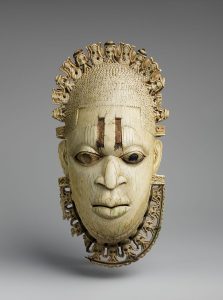
Pendant mask
Benin
16th century CE
-Image by the Metropolitan Museum of Art, used under a Creative Commons Zero (CC0) license, Public Domain
-Learn more about this artwork and find the image source here.
Ceremonial masks are one of the best-known and most important of the premodern African art styles. Most such masks depict men, and were likely worn by men during ritual, but this is a rare example of a mask depicting a woman. This ivory mask was commissioned by a 16th-century king in Benin in honor of his mother, but worn by the king in order to commemorate her.
Masks like this one are still worn in rites, rituals, and ceremonies of renewal and purification in Africa today. Pieces such as this one, which are ancient in origin but represent a living spiritual legacy that still exists today, remind us that religious art is not static, and cannot only be found behind glass at a museum, to gaze at and take photos of. There are efforts around the world supporting repatriation, or the return of ancient art to its original homeland.
Questions for reflection
- Describe this ceremonial mask in close detail. What is the woman depicted here wearing in her necklace and headdress? What do those elements mean or symbolize?
- In what kind of ceremony or ritual do you think this mask was worn?
- This mask was commissioned and worn by a man to honor and remember his mother. Do you have any family heirlooms that remind you of your loved ones?
- What do you think about the idea of repatriation of ancient objects? Should ancient objects be returned to their homelands? Why do we keep objects in museums anyway?
Sources and further reading for this art
How to Read Portraits – The Metropolitan Museum of Art
4.
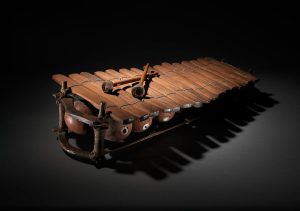
Mali
19th century CE
-Image by the Metropolitan Museum of Art, used under a Creative Commons Zero (CC0) license, Public Domain
-Find the image source and learn more about this artwork here.
This is a wooden musical instrument, an xylophone, from a region of West Africa. When we study musical instruments as visual art pieces, of course we cannot hear the way they sound; we can only imagine. But the craftsmanship of a musical instrument, and its visual details, are a part of its artistry as well.
The wooden slats of the bala instrument are smoked by the creator so that, when struck, they will produce a precise pitch. To help the instrument create sound, it also has two other elements: gourds that make a resonating sound, and membranes that make a vibrating sound. The instrument is played with a rubber-tipped mallet. This example is from the 19th century, but this kind of instrument is still in use by African musicians today.
Questions for reflection
- Describe this instrument and all the different parts of it that you can see in careful detail.
- Imagine what you think this instrument would sound like, or the ritual or ceremony where it might be performed.
- Do you play any musical instruments? What is your favorite instrument or style of music? Why do you love it?
Sources and further reading for this art
Gallery Concert: Kakande Quartet Performs Music of the Mandé Empire – The Metropolitan Museum of Art
5. 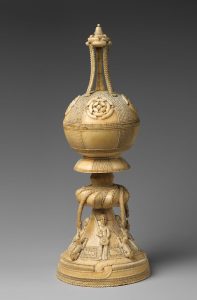
Saltcellar
Sierra Leone
1500 CE
-Image by the Metropolitan Museum of Art, used under a Creative Commons Zero (CC0) license, Public Domain
-Learn more about this art and find the image source here.
This ivory vessel for holding salt, called a saltcellar, provides us evidence for both “kinds” of trade between civilizations: tangible objects, and intangible ideas, like artistic styles. This saltcellar was made in Sierra Leone, but it was likely commissioned by a Portuguese settler to the area, inspired by local art styles and materials—it is made of ivory, a traditional sub-Saharan African material.
In its iconography and art styles, this saltcellar combines a European aesthetic, similar to hunting scenes, with African iconography—the snakes on the bottom of the vessel represent wealth, while the dogs depicted symbolize guarding against malevolent spirits and animals. And of course, it also represents tangible trade—salt and pepper were two of the most valuable trade commodities around the world in the premodern period. So this multicultural saltcellar would have been a luxury object both outside and inside. As we learned in an earlier chapter, when it comes to ancient containers and vessels, it’s what was inside that counts!
Questions for reflection
- Describe the scene at the bottom of this saltcellar in careful detail. What do you see?
- Imagine the life of the wealthy patron who once owned this saltcellar, and the salt that was once kept inside.
- Why were salt and pepper such valuable commodities in the ancient and medieval world?
Sources and further reading for this art
The Art of Africa: A Resource for Educators – The Metropolitan Museum of Art
African Ivories – The Metropolitan Museum of Art
Credo Reference – Introduction: World Trade in History
Media Attributions
- Kongo artist-Crucifix-16th17th century
- Nigerian divination vessel
- Pendant mask Benin
- Bala-African musical instrument
- Saltceller
